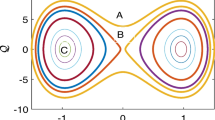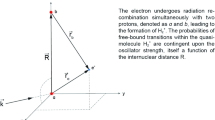Abstract
We study effects of a magnetic field on the classical bound motion of a highly excited (Rydberg) electron around a polar molecule, the latter being treated as the point-like electric dipole. We consider the magnetic field B to be parallel or antiparallel to the electric dipole, so that the system has the axial symmetry. (The \({B} = 0\) case was studied analytically in one of our previous papers.) We obtain analytical results for the arbitrary strength of the magnetic field. We show that the presence of the magnetic field opens up new ranges of the bound oscillatory-precessional motion of the Rydberg electron, the oscillations being in the meridional direction (\(\theta \)-direction) and the precession being along parallels of latitude (\(\varphi \)-direction). In particular, it turns out that in one of the new ranges of the motion, the period of the \(\theta \)-oscillations has the non-monotonic dependence on primary parameter of the system. This is a counterintuitive result.
GraphicAbstract










Similar content being viewed by others
Data Availability Statement
This manuscript has no associated data or the data will not be deposited. [Authors’ comment: There are no external data associated with this manuscript.]
References
S.C. Moldoveanu, V. David, Intermolecular Interactions. In: Essentials in Modern HPLC Separations. Chapter 4. Elsevier: Amsterdam, (2013)
B. Gadway, B. Yan, Strongly interacting ultracold polar molecules. J. Phys. B: At. Mol. Opt. Phys. 49, 152002 (2016)
D.S. Jin, J. Ye, Polar molecules in the quantum regime. Phys. Today 64, 27 (2011)
T. Lahaye, C. Menotti, L. Santos, M. Lewenstein, T. Pfau, The Physics of Dipolar Bosonic Quantum Gases. Rep. Progress Phys. 72, 126401 (2009)
K. Fox, Classical motion of an electron in an electric-dipole field. II. Point dipole case. J. Phys. A (Proc. Phys. Soc.) 1(Ser. 2), 124–127 (1968)
R.S. Jones, Circular motion of a charged particle in an electric dipole field. Am. J. Phys. 63, 1042–1043 (1995)
K.T. McDonald, Motion of a Point Charge near an Electric Dipole. (1996), http://www.hep.princeton.edu/~mcdonald/examples/dipole.pdf
E. Oks, Oscillatory-precessional motion of a rydberg electron around a polar molecule. Symmetry 12, 1275 (2020)
Funding
This work received no external funding.
Author information
Authors and Affiliations
Contributions
As the sole author, I contributed 100% to this paper.
Corresponding author
Ethics declarations
Conflict of interest
The author declares no conflict of interest.
Appendix: Formulas from paper [8] referred to in the main text
Appendix: Formulas from paper [8] referred to in the main text
Rights and permissions
About this article
Cite this article
Oks, E. Analytical results for the motion of a Rydberg electron around a polar molecule: effects of a magnetic field of the arbitrary strength. Eur. Phys. J. D 75, 276 (2021). https://doi.org/10.1140/epjd/s10053-021-00286-2
Received:
Accepted:
Published:
DOI: https://doi.org/10.1140/epjd/s10053-021-00286-2




